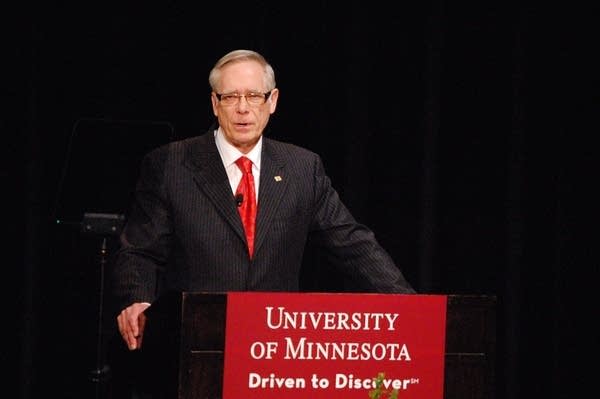Aid cushions blow of state tuition hikes
Go Deeper.
Create an account or log in to save stories.
Like this?
Thanks for liking this story! We have added it to a list of your favorite stories.

If you're a college student, or a parent helping pay the bills, it's hard not to be alarmed at the rise in college tuition in recent years.
The average yearly tuition bill at Minnesota's public and private colleges has gone up 82 percent in the last decade.
At the University of Minnesota it was 107 percent; at MnSCU four-year colleges it was 90 percent; MnSCU two-year institutions saw a 79 percent increase, and private colleges recorded a 52 percent rise.
On a national scale it appears financial aid has kept pace with the increasing cost of tuition, at least over the last few years.
Turn Up Your Support
MPR News helps you turn down the noise and build shared understanding. Turn up your support for this public resource and keep trusted journalism accessible to all.
A recent study from the College Board shows average net tuition, when adjusted for inflation, is lower at public and private colleges than it was five years ago.
That finding pushes a point that University of Minnesota President Robert Bruininks makes every chance he gets.
"If you just look at sticker price, rather than real cost, you get a misleading picture of what's happened," Bruininks said.

The net price of tuition hasn't gone down in recent years in Minnesota, as it has nationally. But figures from the state Office of Higher Education show it's increased at a slower rate than the sticker price.
For instance, from 2005 to 2008, what most students pay for college went up about 3 percent, one-third of the sticker price increase.
According to the Minnesota Office of Higher Education, the average yearly tuition at the University of Minnesota has gone up $2,600 since 2005. This year it's nearly $11,500.
But Bruininks adds that in recent years the U of M has increased the amount of aid it gives to students.
Low-income students, who make up 12 percent of undergraduates, attend the university for free. Even middle-income families, who make anywhere from $60,000 to $90,000 a year, can receive scholarships, on the order of $750 to $1,500.
"If you just look at sticker price, rather than real cost, you get a misleading picture of what's happened."
By some accounts, finding college financial aid has become easier throughout the higher education system.
The federal government is offering more money to students from lower income families, about $620 per student more this year and $820 per student next year. There's also been a $700-a-year increase in a tax credit for families paying for college.
And more colleges have increased aid to needy students.
St. Catherine University in St. Paul raised tuition about 5 percent this year, but raised financial aid to students by 13 percent, according to Elizabeth Stevens, the school's director of financial aid.
"The increases in tuition have been more than offset by the increase in financial aid that the institution is providing to our students," she said.
One of the beneficiaries is freshman Mysee Chang, who keeps all her financial aid information neatly organized in one big binder.
"I have the federal Pell Grant, which is $1,450 per semester. I have Minnesota State Grant, that's $1,477 per semester. And then I have the Page Scholarship, which is $750 per semester."
Chang will pay this year's $28,000 tuition bill at St. Catherine University through this mix of scholarships, federal and state grants, and financial aid from the college itself. She's confident she won't need to borrow money to pay for tuition, at least not this year.
That's not the case for a lot of students. A recent report from the Project on Student Debt shows that 2008 college graduates in Minnesota were saddled with an average debt load of $25,558.
The talk of net price is also lost on the one-third of families who don't qualify for financial aid.
Take for instance Val Swanson of Willmar, who's married with three children -- and all of them are "in some form of college," she said.
The Swanson family makes too much to get student aid, like Pell Grants. And while Swanson says the family has saved money for college, they were surprised at how fast the cost went up in the last few years.
"I think we were pretty aggressive at this when our kids were elementary (age) -- fifth, sixth grade. When I see people now with little kids I say, 'Start saving now,'" she said.
Tuition prices are expected to continue to rise in coming years. It is, however, going to get easier to figure out how much college will actually cost.
By the end of October 2011, all U.S. colleges must post a net price calculator on their Web sites to help students determine their tuition bill, with financial aid and tax breaks figured into the equation.
Dear reader,
Political debates with family or friends can get heated. But what if there was a way to handle them better?
You can learn how to have civil political conversations with our new e-book!
Download our free e-book, Talking Sense: Have Hard Political Conversations, Better, and learn how to talk without the tension.





